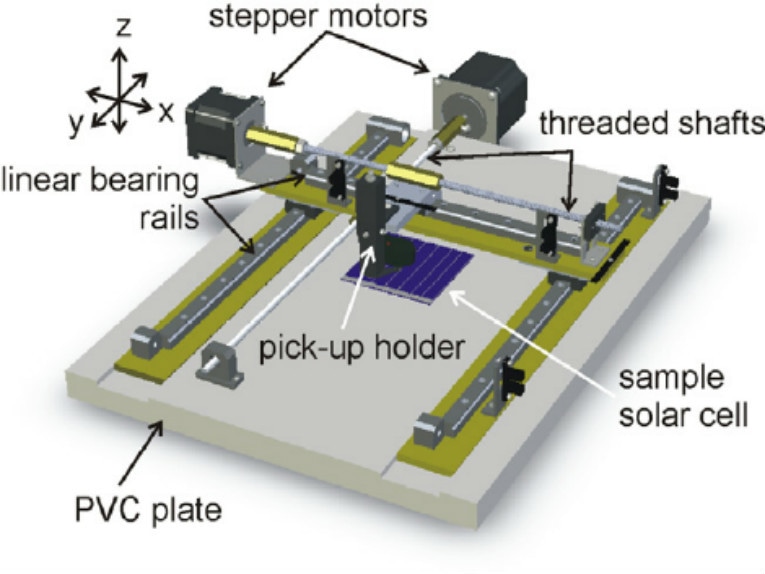The main advances in motion over the last decade have occurred in control systems and electronics.
Positioning stages today can satisfy specific and demanding output requirements. That’s because customized integration and the latest in motion programming now help stages get incredible accuracy and synchronization. What’s more, advances in mechanical parts and motors are helping OEMs plan for better multi-axis positioning-stage integration.
Mechanical advances for stages
Consider how traditional stage builds combine linear axes in X-Y-Z actuator combinations. In some (though not all) cases, such serial kinematic designs can be bulky and exhibit accumulated positioning errors. In contrast, integrated setups (whether they’re in the same Cartesian-stage format or other arrangements such as hexapods and Stewart platforms) output more accurate motion dictated by controller algorithms with no motion-error accumulation.
Conventional screw-driven stages (with a motor and gearing on one stage end) are easy to implement when the payload doesn’t need its own power supply and overall length is a non-issue. Otherwise, gearing can go inside the stage at the motor end of travel, so only the motor length adds to the overall positioning-stage footprint.
Where needed, Cartesian setups can also minimize error when pre-integrated with specialty components—linear motors, for example. These are currently making big inroads in production machinery for high-speed packaging.
Some such subcomponents even come in forms that challenge traditional notions about stage morphology. “Curved linear-motor sections enable complete oval loops of power transmission. Here, guide wheels keep the moving element at precise distances away from the magnets for optimal force translation. Special wheel materials and bearing designs are necessary for the high acceleration rates—motion systems impossible only a few years ago.
On smaller positioning stages, more accurate feedback devices, efficient motors and drives, and higher-performing bearings boost performance—especially in nanopositioning stages with integrated direct-drive motors, for example.
Elsewhere, custom versions of traditional rotary-to-linear components help keep costs down. Large-format applications can splice together servobelt stages without length limitation. Powering such long-stroke stages with linear motors can be too expensive, and powering them with screws or conventional belts can be challenging.
When deciding between a custom solution or an off-the-shelf design, it really comes down to application requirements. If an off-the-shelf solution is available and meets all application requirements, this is the obvious choice. Typically, customized setups are more expensive but are exactly tailored to the application at hand.
Advances in positioning stages’ electronics
Electronics with low-noise feedback and better power amplifiers help boost positioning-stage performance, and control algorithms are improving positioning accuracy and throughput. In short, controls give engineers more options than ever for networking and correcting the motion of positioning-stage axes.
Consider how today’s packaging-line integrators don’t have time to build multi-axis functions from scratch. These engineers simply want robots that communicate and simple product flow through a series of workstations. In an increasing number of cases, the answer is special-purpose controls, partly because controls are far more economical than they were ten years ago.
Applications spur positioning-stage innovation
Several industries—semiconductor and electronics, medical, aerospace and defense, automotive, and machinery manufacturing—are spurring changes in today’s stages and gantries.
Although manufacturers deliver custom designs to all industries, high-tech industries (such as medical, semiconductor and data storage) are the ones pushing for more specialized stages. This is mainly from customers looking for competitive advantage.
Others see it a bit differently. There is increasing need for small, high-precision motion components for applications in advanced research, life sciences and physics. Small-footprint high-precision motion stages, such as the Miniature Precision (MP) series, are now available from FUYU for demanding scientific applications.
Large-scale industry moves to miniaturization have certainly driven some positioning-stage design to customization. The consumer electronics market is a driver in miniaturization, especially related to packaging in the form of thinner phones and thinner TVs, for example. However, with those physically smaller devices come increased performance such as more storage and faster processors. Getting better performance here requires faster and more accurate automation stages.
However, device packaging and optical coupling requirements are well below a micrometer. Coupling these tolerances with the throughput requirements of volume production creates a difficult automation challenge. In many of these cases, the stage or stages—or more importantly, the complete automation solution—must be custom to fit the exact needs of the end customer.
Post time: Sep-07-2020








